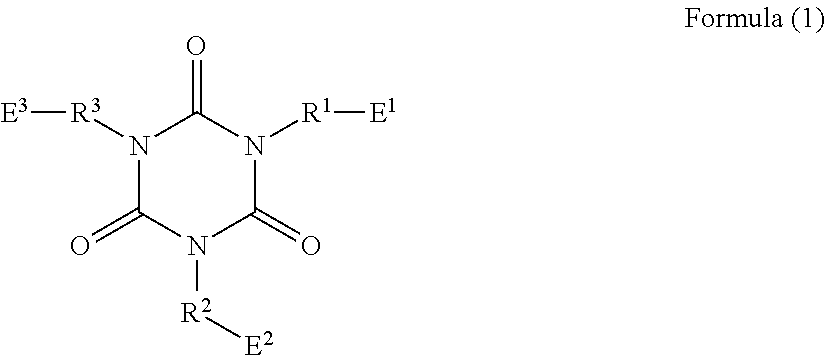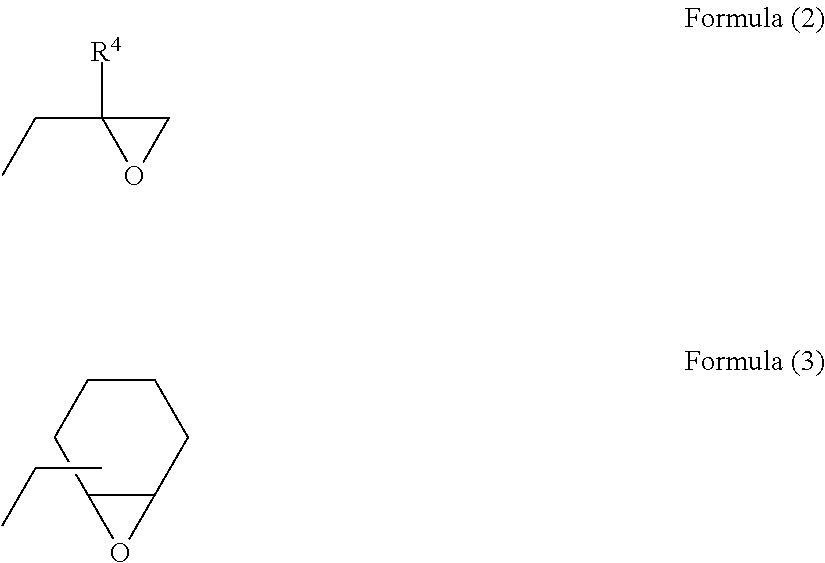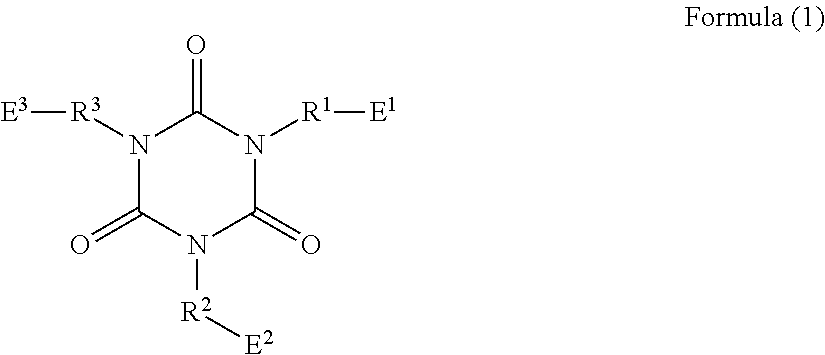Long-chain alkylene-containing curable epoxy resin composition
a technology of epoxy resin and composition, which is applied in the field of photoor heatcurable resin composition, can solve the problems of limited application range, inability to mold, and limited application range of crystalline epoxy resin, and achieves the effects of reducing the content of such a curing agent, good storage stability, and high curing speed
- Summary
- Abstract
- Description
- Claims
- Application Information
AI Technical Summary
Benefits of technology
Problems solved by technology
Method used
Image
Examples
synthesis example 1
Synthesis of tris-(4,5-epoxypentyl)-isocyanurate
[0114]In a reaction vessel, 106 g of isocyanuric acid and 420 mL of water were charged to make a slurry. Next, to the reaction vessel, 206 g of 48% aqueous sodium hydroxide solution was added dropwise, and the whole was reacted at a temperature of 60 to 70° C. for 2 hours. Then, water was removed by evaporation, and the residue was washed with methanol and dried to afford 157.5 g of sodium isocyanurate as a white crystal. In a reaction vessel equipped with a stirrer and a condenser, 400 mL of dimethylformamide was charged as a solvent, and 157.5 g of sodium isocyanurate and 361.4 g of 5-bromo-1-pentene were reacted at 120 to 125° C. for 6 hours. Then, an inorganic salt was filtered off, and the filtrate was extracted with toluene. The extract was washed with water and dried, and the solvent was removed by evaporation to afford 205 g of tris-5-pentenyl isocyanurate as a pale brown oil. In a reaction vessel equipped with a stirrer and a ...
synthesis example 2
Synthesis of tris-(5,6-epoxyhexyl)-isocyanurate
[0116]In a reaction vessel, 106 g of isocyanuric acid and 420 mL of water were charged to make a slurry. Next, to the reaction vessel, 206 g of 48% aqueous sodium hydroxide solution was added dropwise, and the whole was reacted at a temperature of 60 to 70° C. for 2 hours. Then, water was removed by evaporation, and the residue was washed with methanol and dried to afford 157.5 g of sodium isocyanurate as a white crystal. In a reaction vessel equipped with a stirrer and a condenser, 400 mL of dimethylformamide was charged as a solvent, and 157.5 g of sodium isocyanurate and 395.4 g of 6-bromo-1-hexene were reacted at 120 to 125° C. for 6 hours. Then, an inorganic salt was filtered off, and the filtrate was extracted with toluene. The extract was washed with water and dried, and the solvent was removed by evaporation to afford 230.8 g of tris-6-hexenyl isocyanurate as a pale brown oil. In a reaction vessel equipped with a stirrer and a c...
synthesis example 3
Synthesis of tris-(3,4-epoxybutyl)-isocyanurate
[0118]In a reaction vessel, 106 g of isocyanuric acid and 420 mL of water were charged to make a slurry. Next, to the reaction vessel, 206 g of 48% aqueous sodium hydroxide solution was added dropwise, and the whole was reacted at a temperature of 60 to 70° C. for 2 hours. Then, water was removed by evaporation, and the residue was washed with methanol and dried to afford 157.5 g of sodium isocyanurate as a white crystal. In a reaction vessel equipped with a stirrer and a condenser, 400 mL of dimethylformamide was charged as a solvent, and 157.5 g of sodium isocyanurate and 327.4 g of 4-bromo-1-butene were reacted at 120 to 125° C. for 6 hours. Then, an inorganic salt was filtered off, and the filtrate was extracted with toluene. The extract was washed with water and dried, and the solvent was removed by evaporation to afford 179 g of tris-4-butenyl isocyanurate as a pale brown oil. In a reaction vessel equipped with a stirrer and a con...
PUM
| Property | Measurement | Unit |
|---|---|---|
| thickness | aaaaa | aaaaa |
| thickness | aaaaa | aaaaa |
| thickness | aaaaa | aaaaa |
Abstract
Description
Claims
Application Information
 Login to View More
Login to View More - R&D
- Intellectual Property
- Life Sciences
- Materials
- Tech Scout
- Unparalleled Data Quality
- Higher Quality Content
- 60% Fewer Hallucinations
Browse by: Latest US Patents, China's latest patents, Technical Efficacy Thesaurus, Application Domain, Technology Topic, Popular Technical Reports.
© 2025 PatSnap. All rights reserved.Legal|Privacy policy|Modern Slavery Act Transparency Statement|Sitemap|About US| Contact US: help@patsnap.com



